No Pain no Gain? What Can We Learn From the Time Course of Muscle Damage After Eccentric Workouts. Plus: What's that Got to Do W/ Your Doctor Sending You to the ER
 |
| Concentration curls are among those exercises, where eccentrics can easily be incorporate. Plus. As the EMG Series shows, this increases the biceps activity by almost 50% compared to the regular barbell curl (learn more). But will it also make you grow faster? |
The potential of negative interference is obviously particularly pronounced, when the the potentially muscle damaging physical activity is performed during the recovery phase. But how long it going to take until the repair and restructuring processes are completed?
In other words: How long would be optimal rest interval for someone who trains really intense with a focus on eccentric overload?
At first sight it seems as if the results of a recent study from the State University of Campinas should help us to bring light into the darkness, but as we are soon going to see, things are (once again) more complicated than common sense would tell us.
The main intension of the researchers was to (I quote) "observe the time course of muscle damage and inflammatory responses to resistance-training with EO [eccentric overload]" (Neme Ide. 2013). To this ends, they recruited 3 women and 5 men in their early twenties who had at least one year of previous strength training experience and had them perform a standardized workout program with the following parameters:
- total duration: 13 sessions (total) distributed evenly across 7 weeks; 2x full body workouts trained every Tuesday & Thursday
 |
| No idea how to schedule your workouts? Learn how to do that and much or in the Step By Step Guide to Your Own Workout Routine! |
- set & rep scheme: 4 sets of 8 reps at 80% of the 1-RM max for eccentrics; since that's more than you can "lift", i.e. move concentrically, the researchers who supervised the sessions had to help the participants on the eccentric part of the movement
- exercises: classic full body workout consisting of bench presses, 45-degree leg presses and bent-over rows
- muscle damage - indicated by the amount of creatine kinase (CK) that leaked from the musculature into the blood,
- overall inflammation - indicated by the change in C-reactive protein (CRP) levels,
- hemtaological paramaters - including red blood cell count (RBC), hemoglobin concentration (Hb), hematocrit (Ht), mean corpuscular volume (MCV), mean corpuscular hemoglobin (MCH), mean corpuscular hemoglobin concentration (MCHC), erythrocyte distribution width (RDW), white blood cell (WBC) count, lymphocyte (LYNF) count, neutrophil (NEUTR) count, and platelet count (PLT).
Don't let your Dr send you to the ER without letting him know that you trained the day before you got your latest bloodwork done.
 |
| Figure 1: Creatine kinase (CK) levels (left) and C-reactive protein (CRP) levels (right) at different timepoints of the 7-week exercise intervention (Neme Ide. 2013) |
"CK and CRP presented significant changes at specific time points, but not for all subjects. Four subjects presented significant changes in CK activity at P2 (+1719%, +1250%, +1281%, and +312% resp.), and other two at P13 (+391% and +139%, resp.). For CRP six subjects presented significant changes at P2 (+1100%, +243%, +3800%, +2500%, +1400%, and +2400%, resp.), one at P4 (+567%), other at P9 (+3200%), three at P11 (+300%, +3400%, and +3900%, resp.), and other at P13 (+1500)." (Neme Ide. 2013)Interestingly, there was no significant correlation between the changes in creatine kinase (CK) and C-reactive protein (CRP) as you would expect if muscle damage and systemic inflammation went hand in hand.
Accommodation? yes! Unequivocal results? No.
Despite the fact that the expected pronounced initial CK response was present only in four out of the eight individuals, the scientists are confirmed that the data they gathered does support their initial hypothesis that there would be an attenuation of muscle damage in the course of the 7-week study period and ascribe the latter to the repeated bout effect a term, scientists use to refer to the protective effects a single bout of eccentric exercise has on the muscle damage during subsequent bouts (Mc Hugh. 2003).
"The potential adaptations that explain the phenomena have been categorized as neural, mechanical, and cellular. Regarding the cellular adaptations there is evidence of longitudinal addition of sarcomeres and adaptations in the inflammatory response following an initial bout of eccentric exercise, limiting also the proliferation of damage." (Neme Ide. 2013)While a similar trend was observed for the CRP levels, the initial increase of the latter was by far less pronounced than for the CK values, so that the levels remained within the physiological norm for active people (the average CK values, on the other hand, were 2x elevated over the already high reference interval for physically active individuals).
Changes in hematological parameters were the exception
 |
| In case your workout program looks anywhere like Adelfo's Overkill Program from April 2012, you better make sure to come up with a new one after no more than max. 3-4 weeks! |
Only two subjects presented significant changes in neutrophils with an unpredictable up and down for subject 7 and a significant 60% increase after the final session in subject 6. In view of the fact that subject 7 was also the only one with detoriations in almost all other blood parameters, it's yet pretty unlikely that this was a result of the workout protocol and not the result of some sort of infection or whatever.
Ok, so what exactly have we learned now? This is actually a pretty good question. I guess one thing we have learned is that physically active individuals can actually shock their doctors with "exorbitantly" high (yet still normal) creatine kinase levels. This does not mean that you can simply ignore constantly elevated / abnormal CK values, but it's important to realize that the 400U/L range your lab report lists is probably not sufficient for your personal CK values if you get blood drawn in the vicinity of a hard workout (on a related note: especially when you are low-carbing and eating high amounts of protein the increase in CK usually goes hand in hand with increases in the "turn protein to energy" enzymes AST and ALT, which are in this case not necessarily indicative of "liver damage").
 |
| There is evidence that the expression of the local factions of IGF-1, MGF & Co., depends on the exercise induced wear and tear (learn more), it would be stupid to assume that there was no turning point at which the beneficial damage turns against you. |
Now this may be a pity, but int the end, the differential CK response could have been totally irrelevant anyway. The pertinent evidence from human studies may be more than scarce, but if we go by the few studies we have, it appears that even a 5x higher CK response to eccentric exercises as it was observed in the non-preconditioned group in a 2011 human study by Flann et al. does not result in significantly different increases in either muscle size, or strength (cf. figure 2).
 |
| Figure 2: Strength and hypertrophy (left) and creatine kinase (CK, right) response in pre-trained and naive individuals in the course of an 8-week eccentric training protocol (Flann. 2011) |
References:
- Flann KL, LaStayo PC, McClain DA, Hazel M, Lindstedt SL. Muscle damage and muscle remodeling: no pain, no gain? J Exp Biol. 2011 Feb 15;214(Pt 4):674-9.
- Kraemer WJ, French DN, Paxton NJ, Häkkinen K, Volek JS, Sebastianelli WJ, Putukian M, Newton RU, Rubin MR, Gómez AL, Vescovi JD, Ratamess NA, Fleck SJ, Lynch JM, Knuttgen HG. Changes in exercise performance and hormonal concentrations over a big ten soccer season in starters and nonstarters. J Strength Cond Res. 2004 Feb;18(1):121-8.
- McHugh MP. Recent advances in the understanding of the repeated bout effect: the protective effect against muscle damage from a single bout of eccentric exercise. Scand J Med Sci Sports. 2003 Apr;13(2):88-97. R
- Neme Ide B, Alessandro Soares Nunes L, Brenzikofer R, Macedo DV. Time course of muscle damage and inflammatory responses to resistance training with eccentric overload in trained individuals. Mediators Inflamm. 2013;2013:204942.
- Schoenfeld BJ. Does exercise-induced muscle damage play a role in skeletal muscle hypertrophy? J Strength Cond Res. 2012 May;26(5):1441-53.


